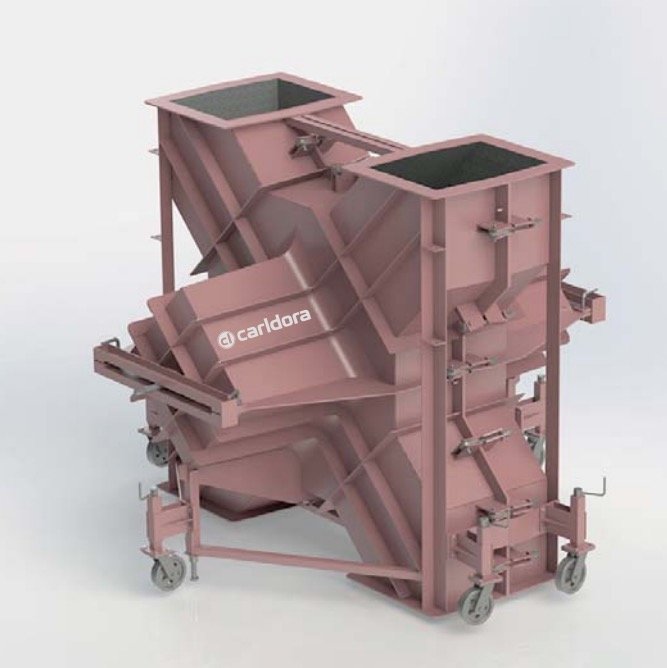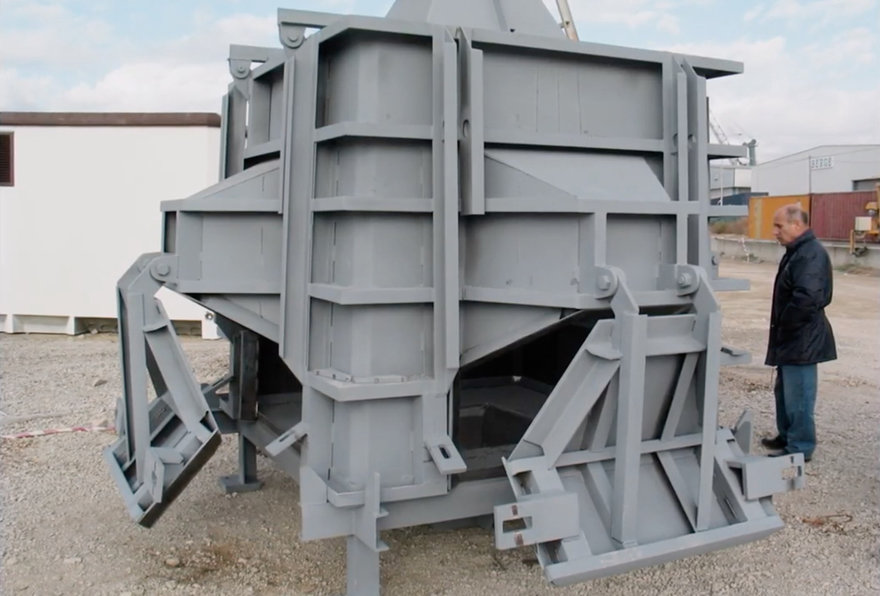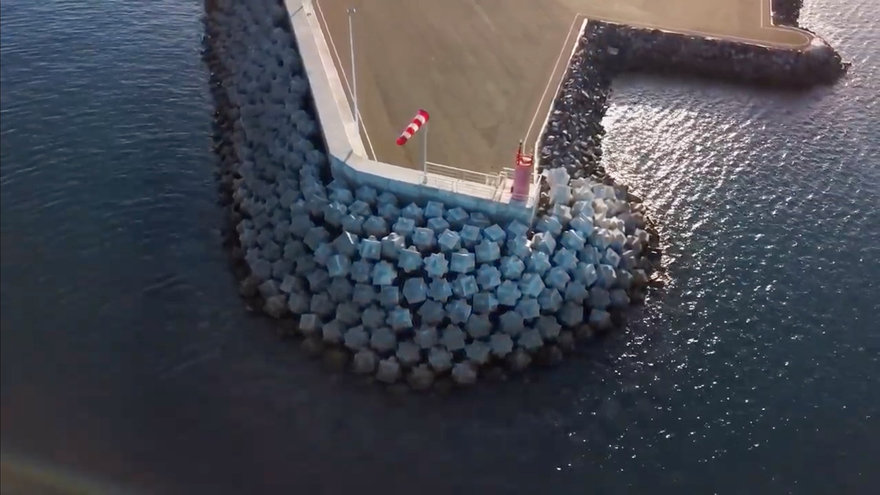Any number of designers can come up with wondrous solutions that don't mean a damn thing if they cannot be manufactured economically and efficiently.
This is a story not only about clever design, but of the clever manufacturing technique that had to be invented in order to realize said design.
The Problem
Ocean waves have a way of beating the living shit out of coastlines. Since that's where our oceanfront properties, coastal roads and all-important ports are located, protection is needed.
 Image credit: NOAA
Image credit: NOAA
The Solution
To defend coasts from flooding, countries around the world install breakwaters, also called revetments. These are collections of massive concrete blocks, dumped into the water and piled atop each other.

The idea is that the waves then slam into the breakwaters rather than the cargo gantries, vacation homes and margarita bars we like to place along the shoreline.

Two Problems With This Solution
1. Building a breakwater requires manufacturing thousands of concrete blocks. A concrete block is relatively cheap to make, but the problem is that all blocks secretly want to be Legos. What I mean is, when you first dump them into the water, they look nice and random and jumbled, like this:

That jumbled-ness is desirable. You want both space between the blocks, and a lot of randomly-angled surfaces, to better dissipate the force of crashing waves. But the problem with cubes is that over time, gravity and movement cause them to inevitably settle, lining themselves up like good soldiers:

You can see the problem. When the water starts to rise, this happens:

Now the blocks have simply formed a smooth ramp that mirrors the seabed, and the waves can once again come crashing up and over.
2. To solve the cubes-like-to-settle problem, revetment designers around the world have come up with all sorts of fun shapes to use in place of cubes. This is like the opposite of Lego, where you're trying to come up with a shape that ensures it's impossible for the pieces to neatly nest together. Here's a sampling of existing shapes:

The problem with any of these will be obvious to any of you with any experience with molds. Cubes are pretty cheap and straightforward to mold. But to create (and operate) molds that can produce any of those other, more complicated shapes above is freaking expensive. In fact, some of those forms above look like the winners of a design competition whose theme is "How complicated and expensive a mold can you design?"
A New Design Solution
So cubes are cheap to mold, but the blocks interlock. Studying this problem, Josep Ramon Medina and Esther Gómez-Martín, two researchers at Spain's Polytechnic University of Valencia, wanted to see if they could design a cube-like shape that had fear-of-intimacy issues and would not lay directly on top of a nearby mate. They came up with a shape called the Cubipod:

The protrusions on all six faces of a Cubipod help the blocks interlock, while preventing them from self-assembling.
For testing, Medina and Gómez-Martín produced thousands of scaled-down Cubipods and filled a model coastline with them.

They found that their new shape did indeed maintain the required irregularity.

A New Manufacturing Solution
Now we run into the problem a lot of designers encounter: "I've got this great new design, but how can I manufacture it economically?" To comprehend the challenge with Cubipods, we first need to understand a couple of things:
1. The logistics of shipping.
Let's say you set up a factory to crank out Cubipods; now how are you going to transport them to the site? Stacking perfect cubes on a flatbed is pretty straightforward; but Cubipods are specifically designed not to get too close to one another, which is great for breakwaters but horrible for fitting them onto a vehicle.

The obvious solution, then, is to manufacture them on-site. Which leads us to the second issue:
2. Understanding how conventional breakwater block concrete molds work.
Take a look at this mold, produced by Portugese manufacturer Carldora, for an X-shaped breakwater block:

To give you an idea of its scale, here's the same mold with the scaffolding in place. Workers must stand atop this scaffold in order to pour the concrete into the sprues:

To release the part, molds of this size and type open laterally.

Here you can see the same arrangement in effect with an H-shaped design for a breakwater block.



Due to the Cubipod's shape and desired on-site manufacturability, this laterally-releasing mold arrangement was "out of the question," says mold designer Antonio Corredor Molguero. A laterally-releasing mold takes up far too much of the limited space available to manufacture breakwater blocks on-site. Instead Molguero and engineering partner Carlos Fermin Menéndez devised a mold that releases vertically.

Once the concrete has set up, the base stays put, and workers swing open four hinged panels on each vertical face that release those pesky undercuts.

Then the entire mold is lifted straight up, releasing a fresh Cubipod.


You might say "Yeah, but then that means you'd need to have a crane on-site." Well, they already have cranes on-site--how do you think they lift the breakwater blocks and move them into the water?
With Molguero and Menéndez's space-saving mold design, multiple molds can be placed quite close to each other, as the releasing action requires little lateral space. That means a lot of Cubipods can be constructed quickly and efficiently.


Wait a Sec, Why are Cubipods Any Better Than Tetrapods?
If you're a civil engineering nerd, or have ever traveled to Japan, or are an industrial design student, you're likely familiar with Tetrapods. Japan's coastlines are littered with this type of breakwater block, and countless, sadistic Industrial Design Drawing 101 instructors forced us to draw these jack-like shapes in perspective, over and over again.

By looking at the Tetrapod's shape, you might reason that they use less concrete than a Cubipod, and that they too are released the same way, i.e. vertically. However, that's not commonly the case. Instead, a top cover that encircles the sprue, plus three circular hatches, plus the three large panels that comprise the top part of a Tetrapod mold, must be individually removed and pulled away to release the part.



This is fairly graceless and inefficient operation that you can witness here.
A Debate Question
I took a close look at Carldora's design for a Tetrapod mold. They've added a bit of innovation with this "Decompression System," which allows the three large panels and three lower hatches to be loosened--but all remain attached to each other as they release the part. They can then be lifted off as a single piece.

However, I believe the Cubipod's mold design is still better, at least from a business perspective. Why? Cost of manufacturing. Take a look at a Tetrapod mold alongside a Cubipod mold:

Supposing the cast blocks were of the same scale, which of those shapes do you reckon is cheaper to manufacture? It's debatable, but I'm guessing the Cubipod mold's flat (if more numerous) surfaces might win the day versus the Tetrapod's finer, curvaceous and more complicated form. But I am not convinced of this, and I'd love to hear opinions from other industrial designers or engineers in the comments.
Conclusion
Thanks to the Cubipod, SATO, the Spain-based coastal construction firm that Molguero and Menéndez work for, managed to reduce their breakwater construction costs from 15% to a whopping 45%, depending on the project. And for their efforts, the duo of Molguero and Menéndez--whom SATO actually lured out of retirement to work on the project, recognizing they needed his expertise*--have been named Finalists for 2019's European Inventor Award.



If industrial designers often go unsung, I'll say mold designers receive even less recognition, so I'm glad to see these two getting their due.

__________
*In the Hollywood movie version of this story, Menéndez quits his job after one of his molds plays a central role in some spectacular tragedy. He swears he'll never design another mold for the rest of his life, sells his belongings and disappears. Molguero tracks him down in some bar in a developing nation, and convinces him to come back for One Last Job.
from Core77 http://bit.ly/2QsIC73
via IFTTT

No comments:
Post a Comment